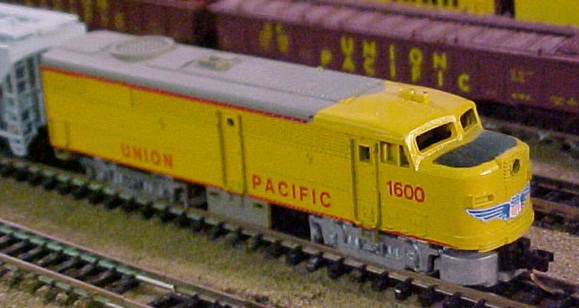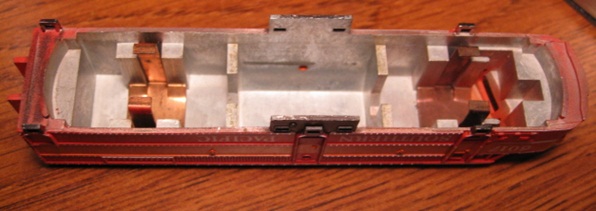

Introduced: 1969
Although not particularly impressive by modern standards, this is a fairly solid 1960s-era diesel model from Arnold. Yes, the paint and shell detailing are somewhat primitive, but performance is quite reliable (if unspectacular). Arnold has always called this an "FA-1", but it's really an "FA-Nothing". Based solely on length it's probably closer to being an FA-2, but none of the shell detailing makes sense for either an FA-1 or an FA-2.
These models were originally imported into the US by Revell (a relationship that would last up until around 1972). After that they had various importers and distributors (Walthers, most notably). Amazingly, these models were available for decades. Arnold was eventually acquired by Rivarossi in the 1990s, and these models all ultimately vanished after Rivarossi's bankruptcy/liquidation circa 2005. The old Revell imports came in cardboard "Revell-Rapido" boxes. Post-Revell, these generally came packaged in the familiar Arnold plastic box with the orange paper insert.
All of the wheels are geared and provide pickup. There are no traction tires. The large can motor actually allows for very impressive slow speed creep (although the top-end speed is pretty much off the charts). The worm gears are pretty darned huge and may actually contribute to the slow speed performance by acting as flywheels. The metal shell is nicely hefty (earning this model kudos as one of the best pulling N scale locos ever). All of the gearing is metal, so these things are really noisy. There is no lighting whatsoever. The couplers are truck-mounted Rapidos (no surprise there). Huge flanges make any turnout an obstacle (and forget about running these on anything like Code-55 track).
There have been a couple of different versions of this model. The earliest versions had less weight inside the shell and "molded-in" air horns on top (IE literally part of the metal shell). Sophisticated graphics apparantly weren't part of Arnold's canon at this point either, as many of these models came with simple paper stickers (EG, early UP versions came with a paper "winged herald" on the nose - later to be replaced by a more traditional printed/painted graphic).

In addition to the graphic changes, later releases added additional weight inside the shell and replaced the molded-in horns with separate plastic horns up top. I can't detect any actual mechanical differences between the two versions, as both seem to perform about the same. I guess the later version might be a little quieter, what with all that extra weight making the shell less of an echo chamber.
As you can see, the mechanism is elegantly simple (and blessedly free of wiring).
Although pulling the shell is not entirely straightforward, it's not too difficult:
1- Remove the fuel tank (pry the shell sides apart to free the tabs)
2- Remove the trucks (just slide them towards the center)
3- Free the motor/worm PCB from the shell by spreading the metal tabs on the shell such that they pop through the holes in the PCB. This part is a little tricky insofar as you have to pull up on the PCB while simultaneously spreading the shell tabs apart.
Grade: C
Reviewed: 11/69 Model Railroader - note: this review thinks the model is an FA-2, even though it is clearly advertised as an FA-1 in ads within the same issue of MR! ("The ready-to-run N scale model is well proportioned, and except for a few deviations is accurately scaled. The body scales about 6" too wide and the front truck is set about 9" too far back. The model comes painted and lettered in Santa Fe or Penn Central colors. The Santa Fe had no such units, however. The model is constructed differently from most other Rapido locomotives in that an all-cast-zinc-alloy body is used rather than a cast metal frame with molded plastic superstructure. The molded plastic truck sideframes have a scale 8'6" wheelbase; the prototype was 9'4". This alteration was no doubt due to the fact that the wheels scale to 48" diameter with .040"-deep flanges (the prototype had 40" wheels), making the overall diameter close to 5 feet... The mechanism is the type used in all Rapido diesels. The small 12-volt DC motor mounted in the center of the body drives all 8 wheels on both trucks... The drive operates smoothly and quietly. All 8 wheels are used for electrical pickup. Our test sample makes a slight lurch when starting but control is otherwise good... Scale speeds are nearly identical to those of other Rapido diesels... This smooth-running model is $11.98. No B units are available")